|
Vieques, Puerto Rico April 29, 2006 |
|
| | |
|
|
Home of 10,000 people and a US Navy Bombing Range
|
Vieques, Puerto Rico
April 29, 2006Sailboat | Voyages | Log
Home of 10,000 people and a US Navy Bombing Range
Anchored all alone in Mangrove hideaway
Ensenada Honda, Isla de Vieques
Unspoiled natural beauty
Exploring Ensenada Honda in dinghy
Full Circle at anchor in background
Just like a Minnesota lake, including mosquitoes
Heading deep into the mangrove
Barracudas lurked just beneath the surface
But no crocks were sighted
Roots of the mangrove trees
Spread their tentacles
Grass on the bottom of the water
Eight feet deep
The water was as clear as glass
Unspoiled natural beauty in mangrove bays
Once again, we were faced with light winds on our stern, forcing us to motor from St. Croix to Vieques. Our anchor was up by 0700, and we were pulling into Bahia Salina del Sur on Isla de Vieques six hours later at 1300. A one to two knot current boosted our boat speed, allowing us to zip through the water at six and a half knots. Upon our arrival to the tranquil bay of Salinas del Sur, we were greet with the following transmission on the VHF radio:
- Sailboat in Bahia Salina del Sur. Sailboat in Bahia Salina del Sur. This is range control for the US Navy.
- Range control this is Full Circle in Salina del Sur.
- Full Circle do not anchor, do not loiter. Leave this area immediately. This is a restricted area. Naval operations can commence at any time. Do not delay. Leave this area immediately. I repeat. Leave this area immediately.
- Roger. We are departing the area. Full Circle out.
- Thank you for your cooperation. Range control out.
This radio interchange occurred after we had been trying to call the US Coast Guard to determine if we were allowed to anchor in the Bay. I thought the call was unnecessary since I had been told that the Navy had discontinued bombing operations in the area. Clearly this was not the case. Once we entered the restricted area, the Navy was on the radio warning us to get out. We left without delay and headed for Ensenada Honda, a beautiful, well protected bay, that was more like a lake than an ocean bay. The water was nearly flat with no ocean swell. If it weren't for a few mosquitoes, it would have been perfect. It was a refreshing change from the sandy beaches. Except for one other boat, nearly a half-mile away, we were alone in two mile wide bay surrounded by mangroves. Besides exploring mangrove rivers by dinghy we had some excellent snorkeling on a nearby reef.
The bays of Vieques are famous for there bioluminescence. On a moonless night, when agitated, the water glows as if filled with tiny lightening bugs. It is a surreal experience to see you body momentarily aglow as you emerge from the water in the dark. Microscopic plankton called dinoflagellates create this mysterious phenomenon.

We were allowed to check in with US Customs via telephone, but since I did not have a US Customs sticker on Full Circle, I was required by Inspector Diaz to report to the Vieques airport the next day and purchase a sticker. This was news to me, but my seasoned cruising party, Ray, knew all about such cruising minutia and proceeded to chastise me for not be cognizant of such matters. It turns out the stickers are required by US Customs for boats greater than 30 feet to return to the United States. They are good for one year. We were forced to leave our mangrove paradise and head for the tiny village of Esperanza, where we could take a "publico," a kind of taxi, to the airport to meet Inspector Diaz and purchase our sticker. It's all part of the cruiser experience. Anyway Full Circle is now fully compliant with US Customs and can legally reenter the US, which she will be doing when she returns from the Bahamas in June.